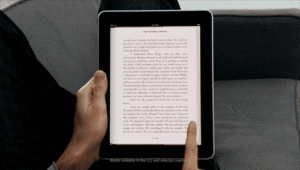The following are the similarities and differences between a printed book and an ebook with flowing text:
Many of the conventions of a printed book are used in an ebook – for example: covers, title pages, copyright pages, tables of contents, chapters, paragraphs, etc.
So … if these are the similarities, what are the differences?
The single most important difference is that printed books have static layouts, while ebooks have dynamic layouts. This is because most ebooks are formatted with fluid text.
What is fluid text? It is “the ability to automatically wrap words in a document to the next line that the user changes the window size and thus changes the right page margin”.
Ebook text
Because ebook text “flows” to fit the size of the screen, ebooks do not have pages like a printed book. Since they don’t have pages, they don’t have page numbers. As they do not have page numbers, you cannot use page numbers as a means of navigation and reference in a table of contents or index.
Instead, you have a table of contents that has hyperlinks to the individual chapters and / or sections of the book. Instead of an index, the reader will use the e-reader search function to search for specific words or topics.
Since ebooks have no pages, there are some other things found in ebooks that are different from printed books. There are no headers and footers in an ebook. Footnotes become “endnotes”. In addition, to ensure predictability of placement, images must be in line with the text and centered. Most eReaders at this point do not work properly with graphs, tables and columns, so they must be converted to an image first.
In an ebook, the reader can define the font type and size, as well as the line spacing, as long as the font has not been incorporated during formatting.
Readers also have the use of the e-reader search function to navigate through the book.
The following items are not used to format ebooks:
- tabulation
- space-bar
- paragraph returns
- symbols
- columns
- text boxes
- colored font (a colored font may make it very difficult to read on some e-Reading devices that do not support color)
- This explanation of some of the similarities and differences between printed books and ebooks with fluid text should help you understand the transition from one to the other.
If you liked the tips, leave a comment! I’d love to hear from you!




Leave A Comment